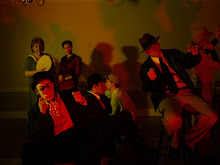Part four in a series of interviews with the cast of
Dog in a Manger at Red Tape Theatre.
1. Where are you from?It's hard to say where I'm from. I was born in Hawaii. Then when I was two, we moved to Rochester, NY. In second grade, I stayed briefly in New Jersey, then eventually Long Island until fourth grade when I found myself in Nashua, NH. Then another great opportunity and new job happened for my dad, and we moved to Walled Lake, Michigan for the last two years of high school. Went to Western Michigan in Kalamazoo, then moved to Chicago. After a brief two year stint in LA, I'm back in where I consider home - Chicago.
So the short answer is "I'm from Chicago"
2. What is the first stage play you remember seeing?I actually wrote a show and performed in two before I saw a live show. In NH high school, I played Lacrosse, Football and Basketball mostly, and for a change, I joined Odyssey of the Mind. We ended up choosing the performance problem and wrote a show in which I was the MC. I did a few shows in high school and it wasn't until I went to college that I actually saw a live theatre performance I was not in. I actually did not realize that until I attempted to answer this question. Interestingly enough, my best friend was in the first show I watched and it was also the first time I met him.
3. When/why did you start acting?I chose acting on a possible sign and a whim. I thought I was going to be a mechanical engineer, and I had applied to four schools I was kind of interested in. I applied to Western Michigan frankly because there was a small application fee, and no essay. I put Theatre as my major of choice, just to see what could happen. Then, one day, I got the acceptance letter from Western while my mom was driving me to rehearsal. It was an overcast day, and as I opened the letter the clouds parted and light broke through. It was weird to say the least.
Those moments are rare and odd and again, weird. I was mulling over the decision, every day after submitting the application I thought about what to do if it worked out, and although I had missed the first department audition, I was generally accepted to the University. When I read the letter in the sudden sunshine, I just felt confident in going forward in the direction of my dreams. It's funny how a small coincidence can suddenly alter the course of one's major life decisions, and we will mull over what cereal to buy for a good half hour and regret it for days after even when it is clearly delicious. I decided that entertaining is important to me and I want to entertain in all facets. I figured theatre training would be a way to get started. Since then, I've been involved in large and small production theatre, tons of improv, stand-up, sit-coms, movies, shorts, I was a tour manager for the Dollyrots travelling all over the US, I've MC'd several events and I've even presided over two weddings. I love entertaining. If given the choice, I would rather be Willy Wonka than one of the kids.
4. Tell us about your character in Dog in a Manger.I play
Ricardo, the inquisitor. He is an overbearing presence to say the least. As an inquisitor, he is used to being in absolute power in most any situation. Since the inquisition is being dismantled slowly, he finds himself basically waving a gun loaded with blanks. As a man of immense power, he has basically been able to say and do whatever he wants. Power does things to people who crave it, and it has definitely warped Ricardo. He has done so much wrong in the name of right that he believes that everything he does is right by default. This man can convince your mother that you have fosaken all that is good and get her to cast the first stone at your death all in the name of God. Personally, I am a gifted skeptic and devil's advocate and so it is interesting to play a true believer.
5. Do you have a favorite moment/scene in the play?If I had to pick a scene I really like to do, it'd have to be the first speech to the audience. I've been a stand-up comic and in general a comedy guy for a while, and to be so blatantly evil and mean with a bit of charm is exquisite for me. I've tried to be mostly a gentle giant most of my life on and off stage, so to be able to bring out my inner asshole is really.... relieving.
As for a scene I like to watch, I like when Belflor hits Teo. It's sweet, vengeful, heartbreaking and ridiculous.
6. What's next for you?What's next? I'm lucky I know what's happening this week. I'm in the pilot episode for A&E's
The Beast, so hopefully we'll all see me and other fine Chicago actors in the winter.
Dog in a Manger runs October 2-26.
Visit
www.redtapetheatre.com for details and to
purchase tickets online!




